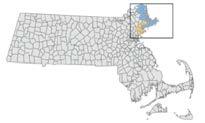ORGANIZING FOR OPPORTUNITY: DEVELOPING THE BLUE ECONOMY ON THE NORTH SHORE

2023 | Volume 25 • Issue 1 MASS BENCHMARKS
The Great Retirement Offers a Path Toward Greater Equity in Small Business Care Work in Massachusetts: A Call for Racial and Economic Justice for a Neglected Sector 26 37
THE JOURNAL OF THE MASSACHUSETTS ECONOMY
State of the State Economy 5
With this issue, MassBenchmarks has reached the end of an era. Our founding Executive Editor and Professor at the Isenberg School of Management at UMass Amherst, Dr. Robert (Bob) Nakosteen, will step back from his formal editorial duties with the journal to enjoy his welldeserved retirement.
Bob has been there every step of the way for the nearly quarter-century history of MassBenchmarks and, at every stage, has been an essential voice, shaping the structure and focus of the journal and bringing his thoughtful and insightful analysis to the “State of the State” feature article, which has opened each issue since our first issue. Throughout it all, Bob has been at the heart of what has made this journal the go-to source for timely analysis and insight into what makes the Massachusetts economy tick and the major policy challenges facing the Commonwealth. He will be sorely missed.
We are pleased to report that Bob will remain Executive Editor Emeritus and a member of the Editorial Board, where his wisdom, good humor, and collegiality have set the standard for our regular meetings and discussions. Indeed, he leaves us with some very large shoes to fill as Executive Editor.
On behalf of our colleagues on the Editorial Board, UMass Amherst, and the entire MassBenchmarks team at the UMass Donahue Institute, we offer our warmest congratulations to Bob on his retirement and our eternal thanks for his many contributions to MassBenchmarks, UMass Amherst, and the Commonwealth of Massachusetts.

MassBenchmarks provides timely information about the Massachusetts economy, including reports, commentary, and data about the state’s regions and the industry sectors that comprise them.
Published by the UMass Amherst Donahue Institute in cooperation with the Federal Reserve Bank of Boston. The views expressed are not necessarily those of the University of Massachusetts or the Federal Reserve Bank of Boston.

CONTRIBUTE The editors invite queries and articles on current topics involving the Massachusetts economy, regional economic development, and key growth industries from researchers, academic or professional economists, and others. A topical outline and brief biography of the author should be sent to info@donahue.umass.edu.
OUR LIBRARY A complete list of past issues, latest news, updates, and additional research on the Massachusetts economy can be found at www.massbenchmarks.org.
MEDIA INQUIRIES
For more information, please contact us at info@donahue.umass.edu.
Michael Goodman and Mary Burke, Co-Editors Mark Melnik and Rebecca Loveland, Managing Editors
CONTENTS
Letter from the Chancellor Kumble R. Subbaswamy
Notes from the Board
Branner Stewart
Massachusetts starts year with surprising signs of economic strength, but potential challenges on the horizon are concerning.
State of the State Economy
Robert Nakosteen & Mark Melnik
In recent months, the Massachusetts economy has comprised a puzzling mix of hesitation and promise—with the economic forecast depending heavily on the direction of inflation.
Organizing for Opportunity: Developing the Blue Economy on the North Shore
David Borges, Michael Goodman, & Katherine Kahl
The North Shore Blue Economy initiative met with hundreds of stakeholders to produce an assessment report on the region’s competitive position in the Blue Economy, showing how the North Shore can build a sustainable and resilient economy around its ocean resources.
Care Work in Massachusetts: A Call for Racial and Economic Justice for a Neglected Sector

Anne Calef
Women of color, particularly Black and immigrant women, are dramatically overrepresented in lowwage care professions. Implementing policies that increase the value of care work would improve financial outcomes and stability for many of these workers and advance racial and economic justice in the Commonwealth.

Endnotes: The Great Retirement Offers a Path Toward Greater Equity in Small Business
Olivia Wine
A recent survey of Massachusetts small businesses highlights racial and gender inequities around responses to the COVID-19 pandemic—as well as opportunities for women, Black, and Latino entrepreneurs to level the playing field.

EXECUTIVE EDITOR
Robert Nakosteen
University of Massachusetts Amherst Professor Emeritus
COEDITORS
Mary Burke
Federal Reserve Bank of Boston
Michael Goodman
University of Massachusetts Dartmouth
SENIOR CONTRIBUTING EDITOR
Alan Clayton-Matthews Northeastern University Professor Emeritus
SENIOR MANAGING EDITOR

Mark Melnik
UMass Donahue Institute
FOUNDING EDITOR
Lynn Browne Brandeis University; Federal Reserve Bank of Boston, retired
EDITORIAL BOARD
• Katharine Bradbury, Federal Reserve Bank of Boston, retired
• Frederick Breimyer, Federal Deposit Insurance Corporation
• Lynn Browne, Founding Editor; Brandeis University; Federal Reserve Bank of Boston, retired
• Peter Doeringer, Boston University, Professor Emeritus
• Robert Forrant, University of Massachusetts Lowell
• Keren Horn, University of Massachusetts Boston
• Michael Klein, Tufts University
• Yolanda Kodrzycki, Federal Reserve Bank of Boston, retired
• Frank Levy, Massachusetts Institute of Technology, Professor Emeritus
• Robert Nakosteen, University of Massachusetts Amherst, Executive Editor Emeritus
• Alicia Sasser Modestino, Northeastern University
• Christopher Probyn, State Street Bank
• James Stock, Harvard University
• Jeffrey Thompson, Federal Reserve Bank of Boston
3 2
5 14 26 37
1 2023 | VOLUME 25 ISSUE 1
This issue of MassBenchmarks examines of several timely economic issues facing the Commonwealth in the blue economy, care work, and small businesses as they emerge from the pandemic.
As it has for over two decades, the issue opens with an analysis of the current state of economic conditions. The first assessment is from the Editorial Board in its quarterly “Notes from the Board,” and the second is in the State of the State Economy feature article authored by UMass Amherst Professor Emeritus Robert Nakosteen and Dr. Mark Melnik of the UMass Amherst Donahue Institute. Both pieces highlight several encouraging signs of economic strength for our state, despite growing concerns about the sustainability of the national expansion and longstanding concerns about labor supply and the cost of living in Massachusetts.

The issue’s major feature articles take a deeper dive into two pressing regional challenges and opportunities. The first examines the presence and opportunities presented by “Blue Economy” industries in the North Shore region, which has long been home to a robust maritime economy. The product of a collaboration between Professor Michael Goodman from UMass Dartmouth, Dr. Katie Kahl from UMass Amherst, and David Borges from the Springline Research Group, this article provides an in-depth profile of the maritime economy along the Commonwealth’s northern coastline. It is already being used by regional stakeholders from business and government to help inform a regional economic development strategy that builds upon established strengths and strikes a healthy balance between the need to organize to capture emerging economic opportunities in areas like offshore wind development and the need for better strategies for coastal resilience and sustainability.
The second feature article documents the extent to which our state relies on social and human service providers or, as author Anne Calef from the Boston Indicators Project at the Boston Foundation terms it, “care work.” Care workers support our most vulnerable neighbors, including our children, elders, and the chronically ill and
disabled, among others. These jobs are essential but require an intensive commitment of time and emotional energy, offer challenging working conditions, and command relatively low wages. Notably, Calef profiles the state’s care workforce and find its workers to be disproportionately foreign-born, female, and persons of color. This raises serious questions about both equity and the extent to which we are adequately investing in a segment of the workforce that we increasingly rely upon for essential supports for our elders, children, and other vulnerable populations.
The issue concludes with a review of some recent and eye-opening public opinion research conducted by the MassINC Polling Group. In this issue's Endnotes, MassINC Polling Group Research Director Olivia Wine offers our leaders in business, labor, and government important insights into the challenges facing our Commonwealth’s small businesses as they emerge from a very difficult pandemic period. These findings make it clear that sustaining and growing these businesses, particularly those owned by women and people of color, will not be easy and will require a renewed effort to support our smaller business enterprises as they contend with a very tight labor market, rising prices, and a changing competitive environment.
Finally, this issue marks the conclusion of Professor Robert (Bob) Nakosteen’s nearly 25year tenure as founder and Executive Editor of MassBenchmarks. On behalf of my colleagues at UMass Amherst, I want to thank Bob for his tireless efforts to make MassBenchmarks the essential resource to our state leaders and policymakers that it has become under his inspired leadership. He will be sorely missed.
Kumble R. Subbaswamy Chancellor of the University of Massachusetts Amherst

LETTER FROM THE CHANCELLOR
MASSBENCHMARKS.ORG 2
The most recent MassBenchmarks Board meeting began with a review of economic data demonstrating better than expected economic performance. Real gross domestic product, in recent quarters, is now on par with or exceeding U.S. averages, payroll employment surged toward the end of 2022, and the unemployment rate has seen one of the largest drops in the country. Additionally, nearly all major industry sectors in Massachusetts are participating in the recent growth.
Despite this confluence of positive trends, the Board has considerable concerns about underlying fissures in the economy that could limit the longer term competitiveness of the Massachusetts


economy. For example, real GDP growth is forecast to slow going into 2023, the working-age population is showing little or no growth, inflation risks remain, and state tax revenues appear to have plateaued. Postpandemic shifts in living and working patterns are also weakening traditional employment relationships. This may be problematic in the longer term for the thriving tech economy and other industries that have benefited from agglomeration economies of location in central business districts. While the effects of the pandemic will be playing out for some time, the Board identified transportation, affordable housing, and geographically targeted economic
development policies as critical factors for helping Massachusetts strengthen its competitiveness now and in the future.
Massachusetts has been outpacing the United States in jobs growth, with the state growing at an annualized rate of 4.2 percent during the fourth quarter compared with the U.S. rate of 2.5 percent. Payroll employment growth in Massachusetts continued to be robust through the second half of 2022, and there were 3.9 percent more jobs in Massachusetts in the fourth quarter of 2022 than in the fourth quarter of 2021. However, U.S. employment surpassed its previous peak (in February 2020) by about 2.0 percent while Massachusetts is still below its previous jobs peak by 0.2 percent.
The continuing decline in the unemployment rate is also an encouraging trend for the Massachusetts economy. The December unemployment rate in Massachusetts stood at 3.4 percent, down from 4.6 percent in December 2021 and somewhat below the U.S. rate of 3.5 percent. While this trend may sound upbeat, the declining unemployment rate has been in part the result of a declining workforce. The December 2022 labor-force was smaller than in December 2021. Moreover, the state’s labor-force participation rate, 67 percent prior to the pandemic, has dropped and is now hovering in the 65 percent range. Both points underscore the challenge presented by a scarcity of available workers going forward.
NOTES FROM THE BOARD
Massachusetts starts year with surprising signs of economic strength, but potential challenges on the horizon are concerning, observes the MassBenchmarks Editorial Board.
Real GDP and jobs growth stronger than expected in the latter half of 2022 but mask issues that may undermine future competitiveness and growth.
2023 | VOLUME 25 ISSUE 1 3
For better or for worse, Massachusetts is inevitably affected by and usually in step with national economic cycles. However, there are a number of issues, some structural, that came to light during the Board meeting. For starters, the impressive growth in payroll jobs (data based on a survey of Massachusetts employers) is not matched by household employment figures (data based on a survey of Massachusetts households). These two data series have historically moved in tandem, but for the past 6 months or so they have diverged (i.e., the number of people in the household survey indicating that they are working has gone down even while the state’s employers report significant increases in jobs). The recent divergence between the payroll and household survey employment trends is accentuating a known problem—that Massachusetts is challenged to supply the labor that businesses in the state need to grow. With little or no labor-force or working-age population growth, the state’s employers are having to draw on labor from elsewhere. Recent growth in the size of neighboring New Hampshire’s labor-force (in contrast with the Massachusetts decline) may indicate that Massachusetts is bringing in labor from other states, whether in-commuting or working remotely. Many of these workers may have previously lived in Massachusetts but have since relocated to New Hampshire while keeping their Massachusetts-based jobs. That trend reflects the combination of being able to work from anywhere, together with Massachusetts’ expensive housing and childcare and its unreliable transit options.
With a declining labor-force and shrinking working-age population, Massachusetts will need to address the longerterm threats to its economic competitiveness. In the wake of the pandemic, the state’s desirable advantages in density and agglomeration appear to be eroding as a factor in business and worker location decisions. With these headwinds, Massachusetts will need to initiate policies that address its high costs, housing, and transportation issues. The state’s numerous advantages in technology development, research, healthcare, growing industries, well-paying jobs, education, culture, and recreation continue to make it a place where people want to live and work, but onerous costs are diverting people to other states with less expensive housing as well as amenity-rich areas where they can work remotely.
A multi-pronged approach is needed to focus on these issues. This would include addressing the housing shortage, including such initiatives as the MBTA Communities law allowing for higher density near transit-served communities. The state can also emphasize place-based economic development, rather than firm-based incentives, to put greater emphasis on retaining and attracting the working population. The pandemic has triggered a shift from centralized in-person work concentrated in large and dense urban areas to decentralized and virtual employment (remote work, fewer office days, and workers not living in proximity to their employer) in many industries. With this shift, the economic development focus needs to redouble its embrace
of making Massachusetts communities and neighborhoods affordable, attractive, and accessible while offering the amenities workers are seeking where they live.
An important part of this equation is a combination of more affordable housing and getting public transportation back on track. Unreliable, delayed, and slow transit service make commuting and other trips a challenge. People working remotely still need to reach the city with some frequency, and unreliable public transit adds to difficulties and costs for workers living in the cities as well as those residing in more distant locations. In particular, the MBTA should and can be an asset for Massachusetts in attracting workers and business, but if it is compounding their existing frustrations, it is yet another motivation for some to pack up and move. The recent steps to improve the MBTA and the new Multi-Family Zoning Requirements for MBTA Communities legislation are examples of how affordable housing and transportation policies can be linked.
Note that the recent collapse of Silicon Valley Bank (SVB) occurred after the February 24th meeting of the Editorial Board of MassBenchmarks. The banking situation clearly represents a new issue that bears close following and increases the downside risks for 2023. This is a national matter, but Massachusetts is highly exposed because of the local concentration of tech, health startups, and the venture capital industry.
This summary reflects the discussion of the members of the Editorial Board of MassBenchmarks at its meeting on February 24, 2023, and it reflects the economic data available up to that date. It was prepared by Branner Stewart, Senior Research Manager at the UMass Donahue Institute, and was reviewed and edited by the members of the Editorial Board. While discussion among the Board members was spirited and individual Board members hold a wide variety of views on current economic conditions, this summary reflects the broad consensus of the Board regarding the current state of the Massachusetts economy.
MASSBENCHMARKS.ORG 4
State of the State Economy
ROBERT NAKOSTEEN & MARK MELNIK
The forecast for the Massachusetts economy in the near and medium term remains mixed. Sluggish job growth, recession fears, high inflation, and increasing interest rates have cooled consumer and business confidence. Yet, despite these signals of a slowing economy, unemployment rates are historically low, job openings plentiful, and wages rising in many sectors. As the Fed focuses primarily on achieving price stability, it seems clear that the future trajectory of inflation will determine the path of both the national and state economies.
Introduction
The state economy in recent months has shown a puzzling mix of signals. After a sustained period of job gains following the COVID-19-induced recession, job growth has appeared to slow. Gross state product declined modestly over the first two quarters but then rose in the third quarter. Fears of recession, coupled with historic levels of inflation, are dampening consumer



and business confidence. Interest-rate hikes by the Federal Reserve Board of Governors (the “Fed”) appear to be having their desired effect of cooling elements of consumer spending, namely on housing, in an attempt to control inflation. On the other hand, the labor market continues to be very tight, with extremely low unemployment rates, robust job openings, and rising wages in several sectors of the economy. All these signals have combined to form a very
unclear picture of the economy in the near and medium term. While the Fed has a dual mandate of achieving price stability and maximizing sustainable employment, its current focus is clearly on the former in the face of accelerating inflation. This suggests that future inflation will determine the path of both the national and state economies.
5 2023 | VOLUME 25 ISSUE 1
Inflation: Where Are We Headed?
Currently, inflation is uncomfortably high, leading to interestrate policy changes that will have consequences for the state economy. In less than a year, the Fed has raised the federal funds rate of interest (i.e., the interest rate banks charge each other for 24-hour loans) from nearly 0 to 4 percent. In addition, the Fed has begun drawing down its balance sheet, which contains a high volume of long-maturity credit instruments. The combination of these two policies will raise short- and long-term interest rates and will have both immediate and more drawn-out impacts on the national economy and
on
Massachusetts.
The Fed focuses its policy decisions on “core inflation,” which strips out both energy prices and food prices. These commodity prices are quite volatile and, when included in comprehensive measures of inflation, can give misleading signals to policymakers. For example, the price of gasoline at the pumps rose sharply when Russia invaded Ukraine but has now returned to pre-pandemic levels. If the Fed had factored high gas prices into their decision making around interest-rate policy, interest rates may have been pushed considerably higher than has been the case.
Inflation has spiked because of a confluence of multiple factors. First came the pandemic, which led to serious disruptions in global supply chains. The quintessence of these disruptions is captured by the serious shortage of shipping containers, which facilitate nearly the entire volume of
international movement of goods. West Coast ports, where virtually all shipments originating from Asia arrive in the United States, experienced diminished capacity as slowdowns and shutdowns due to COVID-19 took their toll. Consequently, container ships formed long queues—in some cases weeks long—at the major ports of Los Angeles and Long Beach, California, among others. Empty containers that were returned to these ports could not be loaded onto ships and sent back across the Pacific; in turn, Asian ports could not acquire containers needed to ship their products. In addition, many major Asian ports were constrained or even shut down due to COVID-19. The cost of shipping from Asian ports to the United States increased tenfold at the peak of the container shortage, with a knock-on effect on the prices of imported products.
A second factor contributing to the sharp rise in inflation has been the multiple rounds of large fiscal stimulus the federal government has injected into the domestic economy to counteract the precipitous drop in economic activity brought on by COVID-19. Unemployment benefits were enlarged and extended, the Payroll Protection Program paid businesses for not laying off their workforce, and most households received multiple stimulus checks from the federal government. While these policies were successful in supporting an economy in free fall, they also led to a surge in consumer spending on manufactured products precisely when the supply of these products was contracting—a perfect recipe for a surge in inflation. At the same time, the Fed injected large quantities of
6.0% 4.7% 0% 1% 2% 3% 4% 5% 6% 7% Jan-19 Mar-19 May-19 Jul-19 Sep-19 Nov-19
Jan-20 Mar-20 May-20 Jul-20 Sep-20 Nov-20 Jan-21 Mar-21 May-21 Jul-21 Sep-21 Nov-21 Jan-22 Mar-22 May-22 Jul-22 Sep-22 Nov-22
U.S. Northeast Boston MSA
■ Source: Bureau of Labor Statistics, CPI for All Urban Consumers (CPI-U), 1982–1984 = 100. All items less food and energy.
Figure 1. Core Inflation for the United States, the Northeast, and Boston MSA for 2019–2022
MASSBENCHMARKS.ORG 6
liquidity into the economy, cutting the federal funds rate to nearly 0 percent and making massive purchases of longterm debt securities. Additionally, the war in Ukraine has led to a spike in energy and food prices.
The higher interest rates engineered by the Fed have immediate effects as well as impacts that will work their way into the economy over the next months to over a year. The most obvious immediate effect is on the housing market. Virtually overnight, mortgage rates jumped from around 3 percent for a 30-year loan to over 7 percent (the rate has since fallen to below 7 percent). This has led to a cooling of the once-hot housing market. The effects on real-estate agents, assessors, inspectors, and others in the real-estate industry are already tangible.
Aside from the market for residences, there is a hypothesis that rising interest rates disproportionately
hurt high-technology firms, which are vital to the Massachusetts economy. While this is debatable, the reasoning is that tech firms, with their higher risk profiles, are more vulnerable to losing investors fleeing interestrate rise. Ultimately, a wide swath of the economy will feel the negative impact of higher interest rates. The Fed’s express goal, achieved by raising interest rates, is to engineer a slowdown in the economy. The real issue is how serious a slowdown to expect, since rising interest rates will undoubtedly dampen economic growth in the state—and could very well reverse it.
However, there are reasons to believe that the rate of inflation has peaked and will start to fall. Crude oil prices as well as gas prices at the pump have been declining steadily. Food prices have come down, and the futures price
of many grains has dropped, presaging further price declines at the grocery store. Core inflation may have peaked as well. Rental payments and homeowners’ equivalent rental payments represent a large fraction of the market basket that determines how inflation is measured— that is, just over 30 percent of overall inflation and nearly 40 percent of core inflation. Rents increased substantially during the worst of the COVID-19 outbreak and are currently built into measured core inflation, but have since moderated considerably. As these moderated rents are folded into inflation measures, the inflation rate will decline. While there may be more interest-rate hikes in the near future, it is likely we will see smaller increases in the coming months.

7 2023 | VOLUME 25 ISSUE 1
There are reasons to believe that the rate of inflation has peaked and will start to fall. Crude oil prices as well as gas prices at the pump have been declining steadily. Food prices have come down, and the futures price of many grains has dropped, presaging further price declines at the grocery store.
Gross Product and Employment
Throughout 2021, the Massachusetts economy showed signs of continued recovery. However, the U.S. economy contracted during the first half of 2022 and was largely stagnant in the Commonwealth, recovering slightly in the third quarter of 2022. In the third quarter, Massachusetts' real gross domestic product (GDP) increased at a 0.5 percent annualized rate, while U.S. GDP increased at a 2.6 percent annualized rate, according to the U.S. Bureau of Economic Analysis (BEA). In the second quarter of 2022, the BEA estimates that Massachusetts' GDP decreased at an annual rate of 2.6 percent, while the U.S. GDP declined at a rate of 0.6 percent. In the first quarter of 2022, the BEA’s annualized growth estimates showed GDP declines of 0.9 percent for Massachusetts and 1.6 percent for the United States.
Despite the apparent improvement in output growth in the third quarter of 2022, the Massachusetts economy appeared to slow within other dimensions as job growth decelerated, the labor-force shrunk (in absolute terms and as a share of the population), and weaknesses emerged in the sectors most affected by rising interest rates, most notably housing. Though inflation does not appear to be accelerating, it remains well above the target levels set by the Fed. Consumer spending has remained robust, but as inflation continues to undermine household wage gains and erode the savings stockpiles accumulated during the pandemic, spending is likely to slow going forward.
Massachusetts has steadily recovered the jobs lost since the initial onset of the pandemic. In April 2020, Massachusetts was

4.5% 8.3% 5.0% 5.8% -0.9% -2.6% 0.5% 6.3% 7.0% 2.7% 7.0% -1.6% -0.6% 2.6% -0.5% -1.2% -4% -2% 0% 2% 4% 6% 8% 10% Q1Q2Q3Q4Q1Q2Q3Q4Q1 2021 2022 2023 Quarterly Growth at Annual Rates (%) Projected
has steadily recovered the jobs lost since the initial onset of the pandemic.
■ Source: U.S. Bureau of Economic Analysis; MassBenchmarks calculations by Dr. Alan Clayton-Matthews.
Massachusetts
MASSBENCHMARKS.ORG 8
Figure 2. Growth in Real GDP, Massachusetts and the United States, 2022 Q3
down nearly 700,000 jobs from its February 2020 peak. As the accompanying graph shows, all but approximately 12,000 of those jobs have been recovered. However, job recovery has slowed. In 2020, Massachusetts added a monthly average of 45,000 jobs. This pace slowed to an average of 15,000 jobs in 2021 and slowed further to an average of 11,000 jobs in 2022. The result has been a long recovery as we approach the February 2020 level of employment.
For much of 2021 and 2022, labor-market conditions improved dramatically for many workers in the United States following the initial wave of COVID-19-related shutdowns. Jobs recovered at a fast rate, with employment totals above prepandemic levels for the nation and 26 states. An additional nine states were within one percentage point of their February 2020 job peak (including Massachusetts).
■ Massachusetts Executive Office of Labor and Workforce Development, Current Employment Statistics (CES-790); UMDI analysis.
101% 99.9% 88% 92% 96% 100% 104% 108% Idaho Utah Texas Florida North Carolina Montana Arizona Tennessee Georgia South Dakota Colorado Nevada South Carolina Arkansas Indiana Washington U.S. Nebraska Oregon Kentucky Maine Alabama New Jersey California Missouri New Hampshire Virginia Oklahoma Massachusetts West Virginia Iowa New Mexico Illinois Wyoming Mississippi Kansas Delaware Pennsylvania Minnesota Wisconsin Connecticut Michigan Maryland Ohio Rhode Island Alaska North Dakota Louisiana New York D.C. Vermont Hawaii
Figure 4. Job Recovery Rates in Massachusetts and All States, February 2020 and November 2022 (Seasonally Adjusted)
■ Massachusetts Executive Office of Labor and Workforce Development, Current Employment Statistics (CES-790); UMDI analysis.
-689.1 -12 Mar-20 Apr-20 May-20 Jun-20 Jul-20 Aug-20 Sep-20 Oct-20 Nov-20 Dec-20 Jan-21 Feb-21 Mar-21 Apr-21 May-21 Jun-21 Jul-21 Aug-21 Sep-21 Oct-21 Nov-21 Dec-21 Jan-22 Feb-22 Mar-22 Apr-22 May-22 Jun-22 Jul-22 Aug-22 Sep-22 Oct-22 Nov-22 0 -100 -200 -300 -400 -500 -600 -700 9 2023 | VOLUME 25 ISSUE 1
Figure 3. Jobs Deficit in Massachusetts Relative to February 2020 Peak in 1,000s (Seasonally Adjusted)
Retail trade, 68,400
Retail trade,82,300
Other services,52,800
While the COVID-19 recession affected people across the Massachusetts economy, both the downturn and the subsequent recovery were deeply uneven. Job losses were most acutely felt in the service sectors of the economy, especially in those industries requiring face-to-face interaction (e.g., tourism, restaurants, and personal care). This led to disproportionate job loss among young people, people of color, women, and workers with less than a college education. Initial job gains were concentrated in knowledge-based industries, particularly in professional, technical, and business services. Only more recently have jobs started to recover in service sectors of the economy. Leading the way in both jobs lost (227,000) and jobs gained (194,600) is the leisure and hospitality industry. This sector, which
Jobs lost in April 2020
Jobs gained as of November 2022
is almost completely dependent on face-to-face interaction between customers and employees, was the most immediately and dramatically damaged by the pandemic. Although it has recovered significantly over the last year-plus, the sector still remains more than 32,000 below peak. Education and health services, and retail trade were both seriously impacted by the pandemic and have yet to fully recover lost jobs. By contrast, several industries currently have higher employment than at the beginning of the pandemic, including construction, information, and wholesale trade. The most notable gains, however, have been in the professional and business-services sector, which has added nearly 35,000 net new jobs since the beginning of the pandemic—a 6 percent increase from the February 2020 peak.
Other
Government,
Manufacturing,27,900 Manufacturing,25,600
trade,
Information, 4,500Information, 9,800 Construction, 51,600Construction, 63,900 Professional and business services, 56,800 Professional and business services,
services, 40,200 Government, 25,900
18,500 Financial activities,8,600 Financial activities, 5,800 Education and health services, 118,700 Education and health services, 116,400
Wholesale trade, 13,600Wholesale
16,700
91,400
Sectors with more jobs than in Feb. 2020 Sectors with fewer jobs than in Feb. 2020
Leisure and hospitality,
Leisure and hospitality,
Transportation, warehousing and utilities,19,300 Transportation, warehousing and utilities,25,700
Mining and logging,100 Mining and logging, 100
194,600
227,000
■ Source: Massachusetts Executive Office of Labor and Workforce Development, Current Employment Statistics (CES-790); UMDI analysis.
MASSBENCHMARKS.ORG 10
Figure 5. Jobs Lost in April 2020 and Jobs Gained as of November 2022 in Massachusetts (Seasonally Adjusted)
Problems in the Labor-Force

One key issue constraining economic growth in both the near and long term is the overall labor supply. The size of the Massachusetts labor-force has largely recovered since the initial collapse at the start of the pandemic. That said, the state’s labor-force is 100,000 individuals smaller than it was at its peak in June 2019. Massachusetts has consistently maintained higher rates of labor-force participation than the United States as a whole. As of November 2022, 65.3 percent of Massachusetts working-age residents were in the workforce. This almost matches the pre-pandemic level of 66.3 percent in January 2020.
These trends related to labor-force size and participation signal the longer term demographic issue facing the state’s labor-force. The fastest growing segment of the state’s population over the next 20 years is projected to be individuals between 65 and 74 years of age. While the size of the labor-force (i.e., those aged 16 through 64 years)
■ Source: Massachusetts Executive Office of Labor and Workforce Development, Local Area Unemployment (LAU) Statistics; UMDI analysis.
Jan-22 Jan-21 Jan-20 Jan-19 Jan-18 Jan-17 Jan-16 Jan-15 Jan-14 Jan-13 Jan-12 Jan-11 Jan-10 Jan-09 Jan-08 Jan-07 Jan-06 Jan-05 Jan-04 Jan-03 Jan-02 Jan-01 Jan-00 Labor Force Labor Force in Current Month Labor Force in April 2020 3,732,564 3,475,101 3,000,000 3,200,000 3,400,000 3,600,000 3,800,000 4,000,000
Figure 6. Massachusetts Labor-Force, January 2000–November 2022 (Seasonally Adjusted)
11 2023 | VOLUME 25 ISSUE 1
The fastest growing segment of the state’s population over the next 20 years is projected to be individuals between 65 and 74 years of age.
Figure 7. Labor-Force Participation Rates in Massachusetts and the United States, January 2000–November 2022 (Seasonally Adjusted)
will grow, the growth is projected to be relatively slow, and the youngest segment of the labor-force is in fact projected to shrink by 2040.
A slow-growing labor-force has been a chronic problem in the state, and the future looks like more of the same. An obvious downside to a slow-growing labor-force is that worker shortages challenge economic growth. The upside, if there is one, is that in a “hightechnology” economy, companies may develop important technologies to make a smaller labor-force more efficient. Nevertheless, many important work settings continue to rely on workers providing face-to-face or in-person work, including child care, education, healthcare, construction, the building trades, auto repair, personal care, and behavioral health services. These sectors remain in critical need of human workers and continue to face serious labor shortages.
Historically, Massachusetts has experienced consistent domestic out-migration from the state and has compensated for this pattern with international in-migration. Therefore, policies designed to decrease domestic out-migration as well as increase international in-migration would be
helpful. Regarding the stemming of outmigration, it has long been hypothesized that the cost of housing in the state, especially in the Boston area, prompts young workers to leave. For years, policymakers have sought politically acceptable ways to lower housing costs— efforts that have proven futile. That said, the state has implemented new
policies to encourage greater housing production, especially in communities along the MBTA system. While this policy is still new, there are elements of resistance to development from communities in some cases. It remains to be seen how these policies will ultimately impact production and prices in the long term. It will be important for
Figure 8. Change in Massachusetts Labor-Force by Age and Sex, 2010–2040
■ Source: Massachusetts Executive Office of Labor and Workforce Development, Local Area Unemployment (LAU) Statistics; UMDI analysis.
■ Source: Massachusetts Executive Office of Labor and Workforce Development, Local Area Unemployment (LAU) Statistics; UMDI analysis.
65.3% 62.1% 50% 55% 60% 65% 70% Jan-22 Jan-21 Jan-20 Jan-19 Jan-18 Jan-17 Jan-16 Jan-15 Jan-14 Jan-13 Jan-12 Jan-11 Jan-10 Jan-09 Jan-08 Jan-07 Jan-06 Jan-05 Jan-04 Jan-03 Jan-02 Jan-01 Jan-00 Labor-Force Participation Rate Massachusetts United States Female Male 0 -30,000 -20,000 -10,000 10,000 20,000 30,000 40,000 50,000 60,000 70,000 16-2425-3435-4445-5455-6465-7475+ MASSBENCHMARKS.ORG 12
Over the long term, Massachusetts must show strong leadership in growing the workforce capacities of its existing immigrant, lower income populations, and other groups with low labor-force participation rates.

local leaders to focus public policy responses on making the state more attractive and affordable to workers across the income spectrum.

Immigration policies that might raise international in-migration are the province of the federal government. In the current political environment, however, there is little to suggest that reform in this area will be forthcoming. Over the long term, Massachusetts must show strong leadership in growing the workforce capacities of its existing immigrant, lower income populations, and other groups with low laborforce participation rates (e.g., people with disabilities, older workers, individuals who have previously been incarcerated, etc.). In light of the severe shortage of critical workers in multiple settings (nursing and healthcare, child care, the building trades, personal and home healthcare, to name a few), leaders can revise regulations and create new programs to provide clear pathways and training to help reduce barriers to entry into areas of the workforce that need workers.
 Robert Nakosteen is Professor Emeritus of Economics at the Isenberg School of Management at UMass Amherst and Executive Editor of this journal.
Mark Melnik is the Director of the UMass Donahue Institute Economic & Public Policy Research Group and Senior Managing Editor of this journal.
Robert Nakosteen is Professor Emeritus of Economics at the Isenberg School of Management at UMass Amherst and Executive Editor of this journal.
Mark Melnik is the Director of the UMass Donahue Institute Economic & Public Policy Research Group and Senior Managing Editor of this journal.
13 2023 | VOLUME 25 ISSUE 1

MASSBENCHMARKS.ORG 14
ORGANIZING FOR OPPORTUNITY:
DEVELOPING THE BLUE ECONOMY ON THE NORTH SHORE





The North Shore Blue Economy initiative — led by the UMass Amherst Gloucester Marine Station in partnership with regional business, community, nonprofit, philanthropic, and thought leaders — conducted an assessment of the region’s blue economic baseline, meeting with hundreds of stakeholders to produce a comprehensive Phase I report. The report offers leaders a foundation for better understanding the region’s competitive position in the Blue Economy.
 DAVID BORGES, MICHAEL GOODMAN, AND KATHERINE KAHL
DAVID BORGES, MICHAEL GOODMAN, AND KATHERINE KAHL
15 2023 | VOLUME 25 ISSUE 1
Overview
The North Shore’s history, economic base, and culture are built around the ocean and the quality of life it provides. Traditional maritime industries, including fishing, tourism, seafood processing, and boat building, are woven into the regional identity. Today, innovation across industry, science, and technology is expanding how we think about the maritime environment to include new and emerging industries such as marine robotics, ocean sensing, marine biotechnology, aquaculture, offshore wind, and coastal-resilience design, engineering, and construction.
Terminology has changed to reflect this broader understanding. Instead of the “Maritime Economy,” we now refer to the “Blue Economy,” defined by the World Bank as “the sustainable use of ocean resources for economic growth, improved livelihoods and jobs and ocean ecosystem health.”1 While the maritime economy has been studied for decades, exploring the North Shore Blue Economy is an approach to
viewing the ocean as a resource that can generate economic growth while also addressing and improving ecosystem health that supports the region’s longterm sustainability. Over the next 10 years, the goal of the North Shore Blue Economy (NSBE) initiative is to build and implement a resilient, sustainable, equitable, and integrated Blue Economy network that builds on regional strengths and positions the region to capitalize on emerging economic opportunities.
The North Shore’s Competitive Position in the Blue Economy
As evidenced in other regions across the state and nation, economic development that builds on existing regional strengths is best positioned for success and prosperity. The Blue Economy is becoming recognized as an important driver of jobs, innovation, and economic growth globally,2 nationally,3 in Massachusetts,4 and regionally (on the South Coast and on Cape Cod). This
article describes the NSBE initiative’s recent efforts to mobilize the North Shore around assessment findings about the area’s economy.
To develop a regional economic development strategy, local leaders must understand their competitive position in the sectors that comprise the regional Blue Economy. Phase I of the NSBE initiative set out to accomplish this through an economic assessment partnership with the Public Policy Center at UMass Dartmouth and the enthusiastic support of regional leaders, including the Cape Ann Chamber of Commerce, City of Gloucester, Gloucester Economic Development and Industrial Corporation, and Essex County Community Foundation. Other supporters include the North Shore Technology Council and North Shore InnoVentures. Throughout the project, the partners have taken a pioneering approach to understanding the strength sectors of the regional Blue Economy.
A report released by the initiative in the fall of 2021 quantifies the regional economic base, identifies

“The North Shore Blue Economy initiative is an exciting opportunity to bring together the diverse perspectives of cross-sector leaders to focus on a path toward sustainable economic development on the North Shore. That means maintaining our maritime heritage and regional culture while creating jobs connected to the health of our ocean and coasts.”
— Dr. Katie Kahl, UMass Amherst Gloucester Marine Station
MASSBENCHMARKS.ORG 16
leading and emerging industry clusters, profiles the current regional population and workforce, and describes the composition, size, and growth opportunities for Blue Economy businesses. As part of its comprehensive assessment, the project team engaged nearly 300 stakeholders to gather their perceptions of regional strengths and challenges, their visions for developing a vibrant Blue Economy, and the steps needed to achieve those visions. The report shares findings, four interconnected opportunities to develop resilient, sustainable, and equitable Blue Economy strategies, and a vision for catalyzing and capitalizing upon those strategies.5
The NSBE Initiative: Leadership and Engagement
Led by the UMass Amherst Gloucester Marine Station, the NSBE initiative was supported and advised by a steering committee of representatives from the Gloucester Economic Development and Industrial Corporation, Cape Ann Chamber of Commerce, City of Gloucester, North Shore Technology Council, North Shore InnoVentures, and Essex County Community Foundation. Additional funding was provided by the Commonwealth of Massachusetts and UMass Amherst Extension. Economic analysis was led by the UMass Dartmouth Public Policy Center and completed by Springline Research Group.
To complement analysis of the regional economy as well as the business landscape and workforce and population dynamics, the initiative engaged stakeholders in a series of meetings focused on identifying sector-specific strengths and challenges, and articulating action steps for achieving a regional vision. The meetings involved nearly 300 regional stakeholders who concluded that a thriving Blue Economy must have better coordinated planning, investment strategies, targeted workforce training, and marketing. Discussion of tangible steps for achieving a prosperous and sustainable Blue Economy centered on (1) developing a coordinated
plan for the region, mapping assets, and assessing business models; (2) investing in infrastructure (dockage, transportation, housing) while retaining the region’s unique culture; (3) engaging young people and attracting new workers by developing targeted workforce training in strength sectors; and (4) marketing and promoting the region’s successes, assets, and vision forward while creating a regional brand that all can envision for themselves.
Geography
The North Shore consists of 21 primarily coastal communities, from Nahant in the south to the New Hampshire state line. These communities are home to an
estimated 435,065 people, comprising 56% of Essex County and 6.4% of the Commonwealth. Economically, the North Shore is strongly tied to the Greater Boston area. However, an analysis of regional commuting patterns shows that there are “Metro North Shore” communities, where the majority of workers commute to Greater Boston, and “Upper North Shore” communities, which have more inter-commuting relationships within the North Shore than with Greater Boston. This differentiation is perceived as a strength, indicating the region has both a strong coastal “self-sufficient” economy as well as communities with a “front door” to Greater Boston’s finance, life-science, and technology-innovation economy.
Lynn
Nahant
Wenham
Salem Marblehead
Hamilton
Peabody Swampscott
Danvers Beverly
Gloucester
Newburyport
Essex
Salisbury Ipswich
Amesbury Newbury Manchester
Rockport West Newbury Rowley Metro North Shore Upper North Shore
■ Source: UMass Dartmouth Public Policy Center
17 2023 | VOLUME 25 ISSUE 1
Figure 1. North Shore Communities, Upper North Shore and Metro North Shore
The North Shore’s Industrial Profile Is Similar to the State’s, but the Region Does Have Competitive Advantages
The North Shore’s economy is based on an industrial mix very similar to the state’s, with Restaurants and Eateries representing the largest industry, followed by Local Education (i.e., K–12 public education) and Individual and Family Services. The region has a much higher concentration of Aerospace Manufacturing than the Commonwealth overall, primarily the result of employment opportunities at General Electric Aviation in Lynn.
Another way to understand the region’s industrial economic base is to examine industry clusters, or groups of related industries in a defined geographic area that share common markets or are interrelated in some way.5 Often, these clusters develop when industries share resources, including common markets, technologies, and labor, or when they require similar natural resources—such as the ocean.
Figure 2 displays the North Shore’s largest industry clusters by number of employees, while Table 1 displays the top 10 growth clusters by employment from 2010 to 2020. Business Services is both the largest cluster and has added the most jobs since 2010; it is also one of the largest clusters statewide and includes a wide variety of industries that support businesses, from taxi and limousine services to consultants and payroll services. The region is also home to four technology clusters—Aerospace and Defense, IT and Analytics, Biopharmaceuticals, and Medical Devices—although many of the region’s top clusters are at least partly technology-related. Two clusters are major components of the Blue Economy: Hospitality and Tourism, the largest Blue Economy cluster, and Food Processing, related primarily to the seafood industry.
Educ./KnowledgeCreationBusinessServices

Two clusters are major components of the Blue Economy: Hospitality and Tourism, the largest Blue Economy cluster, and Food Processing, related primarily to the seafood industry.

8,181 7,655 6,921 5,383 4,861 3,631 3,521 2,851 2,281 1,782 1,762 0 3,000 6,000 9,000
Aerospace&Defense Distribution&ElectronicEquipmentIT&AnalyticsMarketing,Design,&PublishingHospitality&TourismFinancialServicesFoodProcessingBiopharmaceuticalsMedicalDevices
■ Source: Emsi, 2020
Source:
Figure 2. Eleven Largest Industry Clusters, North Shore, 2020
■
Emsi, 2020
Business Services Marketing, Design, & Publishing Food Processing & Manufacturing Hospitality & Tourism Medical Devices Performing Arts Transportation & Logistics Communication Equip. & Services Biopharmaceuticals Education and Knowledge Creation Industry Cluster Increase in Jobs (2010–2020) 2,097 1,161 776 696 421 238 200 145 128 195 % Increase in Jobs (2010–2020) 35.3% 42.1% 53.0% 23.7% 31.0% 35.5% 48.8% 53.2% 50.0% 4.1%
Table 1. Ten Fastest Growing Industry Clusters, North Shore, 2010–2020
18 MASSBENCHMARKS.ORG
Industry Clusters by Location Quotient


A location quotient (LQ) analysis was used to identify industries and activities that give the North Shore a competitive advantage relative to the entire nation. An LQ above 1.0 means that the region has an above-average concentration of employment in that industry cluster compared with the nation. Clusters with both a high LQ and relatively high total job numbers typically form a region’s economic base. Table 2 presents the North Shore’s industry clusters with an LQ above 1.0. As shown, the region is most specialized in the Fishing and Fishing Products industry cluster as well as several technology-based clusters such as Aerospace and Defense, Medical Devices, and IT and Analytics. These industries, along with other regionally specialized and emerging industries (e.g., Biopharmaceuticals, Marketing, Design, and Publishing) show competitive advantage and highlight opportunities for growing and promoting the region’s Blue Economy in both traditional and tech-oriented sectors.

 ■ Source: Emsi, 2020
■ Source: Emsi, 2020
Products
Vehicles & Defense Biopharmaceuticals Medical Devices IT & Analytics
Creation Marketing, Design, Publishing Food Processing and Mfg. Performing Arts Lighting & Elec. Equipment Downstream Chemical Products Financial Services Industry Cluster LQ 11.2 8.4 4.7 4.7 2.9 1.9 1.6 1.5 1.2 1.2 1.1 1.1 Employment 900 6,921 1,782 1,762 4,861 8,181 3,631 2,281 980 483 400 2,851 19 2023 | VOLUME 25 ISSUE 1
Table 2. Industry Clusters with an LQ above 1.00, North Shore, 2020
Fishing/Fishing
Aerospace
Education/Knowledge
Importantly, an industry cluster may have a high LQ but low or declining levels of employment and therefore may not be as vital to a region’s economy compared with clusters with lower LQs. Figure 3 displays the LQ for each industry cluster in relation to its size and employment growth from 2010 to 2020, with the size of each circle representing total employment. For example, Living Resources and Aerospace Vehicles and Defense are “Mature” industry clusters with high employment concentrations—indicating regional specialization—but shrinking labor-forces. Biopharmaceuticals and Medical Devices are examples of “Expanding” clusters, meaning they have above-average employment concentrations and are experiencing employment growth.
Clusters with both a high LQ and relatively high total job numbers typically form a region’s economic base. An LQ above 1.0 means that the region has an above-average concentration of employment in that industry cluster compared with the nation.
The North Shore is similar to the Commonwealth in many ways, with a growing population, high educational attainment rates, and low poverty levels. There is significant daily commuting to and from the region, which congests roads and lowers productivity as
workers spend considerable time behind the wheel. Local opportunities that match these workers’ skills or new ideas that incubate regional innovation present an opportunity to keep the region’s most highly skilled workers employed in the North Shore.

2020
Education/Knowledge
0 Biopharmaceuticals Business Services Construction Products/Services Downstream Chemical Products Financial Services Food Processing and Mfg. IT & Analytics Lighting & Elec. Equipment Marketing, Design, Publishing Medical Devices Metalworking Tech. Performing Arts Hospitality and Tourism -4 -2 0 2 4 6 8 10 12 -80% -60% -40% 0% 20% 40% 60% Mature (Strong but Declining) Expanding (Strong & Growing) Contracting (Weak & Declining) Emerging (Weak but Growing) Distribution/Electronic Commercial Equipment Insurance Services Plastics Printing Services Fishing/Fishing Products Aerospace Vehicles & Defense Location Quotient (LQ) Percent Change in Jobs, 2010–2020 Prod. Tech. & Heavy Machinery -20%
Figure 3. Industry Clusters by Location Quotient and Employment Growth, North Shore, 2010–20206
■ Source: Emsi,
■ Note:
Creation cluster is omitted for scaling purposes.
MASSBENCHMARKS.ORG 20
Blue Economy Sector Assessment
Throughout the colonial and post-revolution periods in coastal Massachusetts, the North Shore Blue Economy centered on shipping and exporting natural resources—primarily old-growth timber, dried cod, and granite. The success of the region’s fisheries depended on locally built schooners and dories, innovative designs that allowed for a more efficient catch. The fishery and the crews that worked the seas of the North Atlantic contributed to the romantic image of the New England fishing village and the courageous individuals who made their living from the sea. In some ways, this romanticized image of the sector persists, even as the modern Blue Economy has evolved in the face of recent challenges.
As the project team’s assessment identified, today’s Blue Economy includes six primary sectors: Coastal Tourism and Recreation, Living Resources, Marine Transportation, Marine Construction, Ship and Boat Building and Repair, and Offshore Minerals. Together, these sectors employ 16,485 workers and account for 7.9 percent of the total jobs in the region. The sectors contribute varying
levels of employment to the region’s Blue Economy. Coastal Tourism and Recreation accounts for 87 percent of the total number of Blue Economy jobs, followed by Living Resources (8.4% of total) and Marine Transportation (2.9% of total).7

Blue Economy jobs grew faster than the larger regional economy. From 2004 to 2020, the number of people working in the Blue Economy grew by 19.5 percent on the North Shore (+2,644 jobs) compared with 12.2 percent growth for all industries in the region during the same period. Most job gains were in the Coastal Tourism and Recreation sector (+2,920), while job losses were experienced in the

Living Resources (-517) and Offshore Minerals (-54) sectors.
As Table 3 shows, Massachusetts and the North Shore have experienced significant growth in the Coastal Tourism and Recreation sector (25.5% and 31.0%, respectively). Conversely, employment in the Living Resources sector declined both statewide and in the North Shore, although the decline was much more extreme in the North Shore (-27.1% compared with -3.2% elsewhere in other Massachusetts’ coastal communities). However, the North Shore has a higher proportion of total Blue Economy jobs as a percent of total jobs compared with the remainder of Massachusetts’ coastal communities.
Table 3. Job Growth by Sector, North Shore versus Remainder of Massachusetts, 2004–2020
■ Source: Emsi, 2020; Author's Calculations Blue Economy Sector Coastal Tourism & Recreation Living Resouces Marine Transportation Marine Construction Ship & Boat Building & Repair Offshore Minerals All Sectors #Change 2,920 -517 242 58 38 -54 2,686 % Change 25.5% -27.1% 103.8% 50.5% 90.0% -77.2% 19.5% % Change 31.0% -3.2% 45.7% 25.6% 16.4% -44.3% 28.4% #Change 20,679 -201 1,445 245 80 -120 22,129 North Shore Massachusetts Coastal Communities
21 2023 | VOLUME 25 ISSUE 1
The strength of the North Shore Blue Economy is a combination of mature and emerging specialized industry clusters and opportunities in both traditional maritime industries and technology-based industries not always perceived as being connected to the ocean.
Figure 4 displays the LQ for each Blue Economy sector in relation to its size and employment growth from 2004 to 2020, which presents a more holistic view of the strength of each industry. Coastal Tourism and Recreation is the only industry in the Expanding quadrant, with an LQ slightly above 1.0 and employment growth since 2004. Living Resources is in the Mature quadrant, with a higher concentration of employment but declining employment levels since 2004. Three sectors comprise the Emerging quadrant; the North Shore is less specialized in these sectors compared with other coastal areas of the state but are beginning to show signs of employment growth.
Opportunities to Grow the North Shore Blue Economy
The North Shore’s emerging growth prospects are tied to four interconnected opportunities that the economic assessment and stakeholder discussions made clear. These opportunities are closely linked to the region’s existing strengths and specializations (e.g., Living Resources, Coastal Tourism and Recreation) and to promising new Blue Economy growth areas. Seizing these
opportunities will require thinking in new, interdisciplinary ways, building additional capacity, and adopting new technologies informed by cross-sector collaboration.
Four Interconnected Opportunities for the North Shore Blue Economy
An Evolving Living Resources Sector
Regional support of innovation and coordination in sustainable approaches to harvesting healthy groundfish populations and building markets for underutilized fish species can reinvigorate the North Shore’s Living Resources sector. Additionally, continued support for the lobster fishery as it responds to pressures related to climate change and gear restrictions may help continue the growth of jobs and revenue that lobstering has seen in the last decade, while exploratory research and pilot projects around shellfish and kelp aquaculture could diversify seafood resources and revenues. Some additional areas for expanding the Living Resources sector include seafood and value-added processing, foodscience research, seafood supply-chain network innovations, and marine biomaterials science.
Living Resources
Marine
Ship & Boat Building Offshore Minerals 0 0.40 0.80 1.20 1.60 2.00 -1.2-1.0-0.8-0.6-0.4-0.20.00.20.40.60.81.01.21.4 Location Quotient Percentage Employment Growth 2004–2020 Contracting (Weak & Declining) Mature (Strong but Declining) Expanding (Strong & Growing) Emerging (Weak but Growing)
1
Coastal Tourism & Recreation
Marine Transportation
Construction
MASSBENCHMARKS.ORG 22
Figure 4. Location Quotient, Growth and Size of Major Maritime Economy Sectors, 2020
2 3

A Developing Marine Science and Technology (MST) Cluster


Innovation often occurs at the intersection of existing industry clusters. Sustainable seafood management, ocean research and engineering, bio manufacturing, marine genomics, drone applications, and big-data management are ripe for new networks and expansion in the region. Access to diverse laboratory, coastal, and marine environments, relatively affordable and available office space, and easy rail connections to and from Boston position the region’s developing MST sector to thrive. MST capacity also positions the region as a destination for training, research and development, and ocean application. The connection to Boston’s life-science, technology, and investment communities is critical to growing MST partnerships and supporting opportunities for homegrown MST workers within (rather than outside) the region.
The Potential for Floating Offshore Wind in the Gulf of Maine

Offshore wind will soon be a major new industry in the United States. At the time of the report, state-level incentives and mandates have created a market of about 30 gigawatts of nameplate capacity. Northeastern states are exceptionally well-positioned to benefit economically from offshore wind since they have the most offshore wind potential and the cheapest costs of deployment.8, 9 The North Shore’s role in the emerging offshore-wind market is evolving, but the region must have a seat at the table for coordinated decision making and be in a position to seize opportunities. Potential regional support of offshorewind development includes boat repair and maintenance services, ocean engineering, construction workers, boat captains, marine sensing and monitoring technologies, and the use of fishing/ lobstering fleets for cooperative research and support.
4

Increased Investment in Coastal-Resilience Science, Planning, and Preparation
Rising sea levels represent a significant threat to coastal ecosystems, communities, and infrastructure through land loss, altered habitats and increased vulnerability to coastal storms, nuisance flooding, and damaging wave actions such as erosion. The Commonwealth, the federal government, and the region are making strategic funding, policy, training, and infrastructure investments. The North Shore must continue seeking creative ways to live with water, innovate around resilient best practices in coastal design, architecture, engineering, and construction, and compete for robust federal funding strategies with a suite of collaborators to safeguard ports, properties, and people.
Coastal Tourism & Recreation Living Resources Marine Transportation Marine Construction Ship & Boat Building & Repair Offshore Minerals
THE NORTH SHORE BLUE ECONOMY
A
Increased investment in coastal resilience
and preparation
An evolving Living Resources sector
developing Marine Science & Technology (MST) cluster
science, planning
23 2023 | VOLUME 25 ISSUE 1
The potential for oating offshore wind in the Gulf of Maine
Despite its longstanding connection to the Blue Economy, the North Shore has lacked a comprehensive and resilient economic development strategy for building on the region’s strengths and capitalizing on new and emerging opportunities in the Blue Economy. The NSBE initiative aims to help local leaders better understand the North Shore’s competitive position in the sectors that make up the regional Blue Economy. The analysis discussed here offers a foundation for building resilient, sustainable, and equitable economic development and community engagement strategies.
The initiative’s goal, over the next 10 years, is to implement and maintain a sustainable and resilient Blue Economy ecosystem in the North Shore through an integrated approach to regional economic development that builds upon existing strengths. These strategies will advance ocean-related economic interests while improving the health of the ocean ecosystem on which regional economies depend. The work of leadership begins with capacity building. Phase II of the initiative will focus on applying Phase I findings to advance four broad targets.
1 2
Grow the North Shore Blue Economy network.
A network of diverse, regionally representative thought leaders across Blue Economy sectors will provide coordinated advisory leadership and inclusive community engagement and serve as a hub for creative economic development and engagement strategies. The network will collaboratively design, guide, and inform (a) strategy development, (b) funding opportunities, and (c) research needs.
Develop workforce training and education to drive Blue Economy. Formation of integrated partnerships among regional research and higher education institutions, government and nonprofit enterprises, workforce incubators and training programs can meet these new employment opportunities. By coordinating workforce development with economic development, the initiative aims to open career pathways with a strong living wage that supports a high quality of life and retains talent.
Brand and market the North Shore’s vision of a resilient, sustainable, and equitable Blue Economy.
Promote the region’s successes and demonstrate Blue Economy activities and assets to attract new businesses, entrepreneurs, investors, scientists, and engineers to areas of opportunity, as well as help existing and traditional workingwaterfront enterprises succeed and expand in this larger market.
3 4
Fundraise and increase access to capital that fosters entrepreneurship and incubates Blue Economy enterprises and initiatives. Develop a cross-sector coordinated and targeted portfolio of state, federal, and private funding opportunities to advance the North Shore Blue Economy and the infrastructure that supports its growth.
A VISION FOR A RESILIENT, SUSTAINABLE, AND EQUITABLE NORTH SHORE BLUE ECONOMY MASSBENCHMARKS.ORG 24
Endnotes
1) World Bank Group (2017). http://www.worldbank.org/en/news/ infographic/2017/06/06/blue-economy
2) “Oceans—United Nations Sustainable Development.” United Nations. https://www.un.org/sustainabledevelopment/oceans/.
3) “NOAA Blue Economy Strategic Plan 2021–2025” (National Oceanic and Atmospheric Administration U.S. Department of Commerce, January 19, 2021). https://aambpublicoceanservice.blob.core.windows.net/oceanserviceprod/economy/ Blue-Economy%20Strategic-Plan.pdf.
4) “Seaport Economic Council,” Mass.gov. https://www.mass.gov/orgs/seaporteconomic-council.
5) For a copy of the full report see: https://www.umass.edu/ses/ nsblueeconomy#download
6) Michael Porter defined industry clusters as “geographic concentrations of interconnected companies, specialized suppliers, service providers, companies in related industries and associated institutions.” See Porter, M. E. (2000). Location, competition and economic development: Local clusters in a global economy. Economic Development Quarterly, 14(1), 15-34. The clusters analyzed in this section were based on Porter’s cluster methodology. See http://clustermapping.us/content/ cluster-mapping-methodology.
7) The jobs reported in the Living Resources sector are likely undercounted because many of the workers in this sector, particularly seafood-processing workers, are hired as contract workers through employment-services agencies and, therefore, are not accounted for in the Living Resources sector data.
8) Beiter, P., Musial, W., Kilcher, L., Maness, M., & Smith, A. (2017). An assessment of the economic potential of offshore wind in the United States from 2015 to 2030 (No. NREL/TP-6A20-67675). National Renewable Energy Laboratory. (NREL), Golden, CO (United States).
9) Musial, W., Heimiller, D., Beiter, P., Scott, G., & Draxl, C. (2016). 2016 offshore wind energy resource assessment for the United States (No. NREL/TP-5000-66599). National Renewable Energy Laboratory (NREL), Golden, CO (United States).
David Borges is Principal at Springline Research Group.


Michael Goodman is Senior Advisor to the Chancellor for Economic Development & Strategic Initiatives and Professor of Public Policy at the University of Massachusetts Dartmouth.
Katherine Kahl is the Director of Strategic Initiatives at the UMass Amherst Gloucester Marine Station and Extension Assistant Professor of Coastal Resilience & Sustainable Fisheries in the Department of Environmental Conservation at the University of Massachusetts Amherst.

To learn more please visit: https://www.umass.edu/ses/nsblueeconomy

25 2023 | VOLUME 25 ISSUE 1

MASSBENCHMARKS.ORG 26
Care Work in Massachusetts: A Call for Racial and Economic Justice for a Neglected Sector
 BY ANNE CALEF
BY ANNE CALEF
Despite the critical support they provide, care workers — who are predominantly immigrant women and women of color — remain undervalued in the economy due to systemic racial and gender discrimination. This article examines the history and projected demand for care work, provides a demographic profile of care workers in the Commonwealth, and describes the alarmingly low job quality many care workers face, including low wages, lack of benefits, and harsh working conditions. The article details key policy strategies that could significantly improve care work job quality and advance racial and economic justice in Massachusetts.


27 2023 | VOLUME 25 ISSUE 1
Introduction
Care work has always been critical to the health and basic functioning of society. With the steady aging of the population, care jobs are among the fastest growing in the national and state economies. Today, these jobs are staffed predominantly by immigrant women and women of color, and despite the societal importance of this work, racial prejudice and gender discrimination have led to its systematic devaluation. Care workers tend to receive low wages, enjoy fewer basic benefits, such as employer-provided health insurance, face harsh working conditions, and experience high rates of occupational injury.
This article offers an overview of the history and projected demand for care work, followed by a demographic profile of care workers and an analysis of care work job quality. The article ends with a selection of policy strategies that could improve care work job quality and advance racial and economic justice in the Commonwealth.
Care workers provide supports that every person requires at some point, whether in infancy or old age, or due to illness or disability. Throughout this article, we focus on three categories of care workers: (1) home care workers, a category that includes those working independently and paid through MassHealth (called personal care attendants in Massachusetts) and those employed by a home care agency; (2) long-term care facility workers; and (3) child-care workers.1 We chose to focus on these fields because they are an often overlooked backbone of
the socioeconomic structure, tend to pay lower wages than many other care professions, and, owing to the legacy of slavery and racial discrimination (detailed later in the article), tend to comprise fields in which Black women, women of color, and immigrant women are concentrated.

A Brief History of Care Work and Race
Before the Industrial Revolution in the United States, care work was almost exclusively performed in the home by women. Society obligated women, in their role as wife, mother, daughter, or sister, to prioritize caregiving for their kin. As is the case today, the context in which women performed care work differed greatly by class and race. Many enslaved Black women were forced into domestic and care roles that were physically taxing, placed them at high risk for abuse of all forms, and denied them the ability to care for their own family. At the same time, wealthy White women’s care work became idealized as a symbol of virtue, nurturance, and domesticity—standing in contrast to the “public” sphere reserved for men.2
This early division between care provided by women of color and care provided by White women of means set the stage for patterns described later in this article. The hard realities of caring for children, the sick, and the elderly was, in many ways, at odds with the ideals of White womanhood, and, ultimately,

THREE MAIN CATEGORIES OF CARE WORK
 Home Care Workers
Long-Term Care Facility Workers
Child-Care Workers
Home Care Workers
Long-Term Care Facility Workers
Child-Care Workers
MASSBENCHMARKS.ORG 28
Care workers provide supports that every person requires at some point, whether in infancy or old age, or due to illness or disability.
Care Work in Massachusetts
50%+
it was the labor of enslaved Black, poor, and immigrant women that resolved this contradiction. White women became the “public face” of care work, performing jobs requiring the most external interaction, while Black women and other women of color became responsible for the most difficult and unpleasant work, such as cleaning floors or performing nursing tasks.3 The racialized and gendered division of labor persisted throughout the late nineteenth and early twentieth centuries.4 As the number of hospitals proliferated in the early twentieth century and medicine became increasingly professionalized, more care work positions developed. However, even in institutional settings, Black women and other women of color were still assigned to the most time-consuming and physically taxing positions, such as certified nursing assistants.
At the same time, care workers were largely left out of early-twentieth-century labor reforms. The National Labor Relations Act of 1935, also known as the Wagner Act, affirmed the right of workers to form and join unions—but notably left out domestic workers. The Fair Labor Standards Act of 1938, which established a federal minimum wage, excluded service occupations and thus left out most women workers, including those in caring professions.5 Not until 2015 were federal protections extended to include most care workers.
Demographic, technological, and cultural changes in the United States led to increased demand for care work throughout the twentieth century. The increase in average life expectancy, from just 47 years in 1900 to 78 years in 2004, led to greater need for elder care, in both home and institutional

settings.6 More women began entering the paid, out-of-home workforce in the mid-twentieth century, and the full-time, unpaid labor they had previously provided was often filled by women of color and immigrants. In 2020, one in five child-care workers nationally and roughly one third of home healthcare workers were born outside the United States. Limited immigration pathways for care workers mean that many foreign-born care workers hold dependent visas or “cultural exchange” visas or are undocumented—all statuses that place them at greater risk for exploitation.7
Projected Demand for Care Work
With the aging of the baby boomer generation, the number of retirees in Greater Boston is expected to grow by more than 50 percent between 2020 and 2040 (from approximately 689,000 residents over the age of 65 to a little more than one million).8 Nationally, the number of adults 85 years and older is expected to triple from 6.7 million in 2020 to 19 million in 2060.9 The rise in adults over the age of 85 is especially notable because disability incidence increases with age. One in three Massachusetts residents between the ages of 80 and 84 have two or more disabilities, and for those aged 85 to 89, the share is closer to 45 percent.10 In addition, a recent AARP study found that 77 percent of adults 50 years of age or older wish to remain in their homes as they age, suggesting that demand for homebased care will grow even faster.
Expected growth of the number of retirees (65 years or older) in Greater Boston from 2020 to 2040 3x
Estimated national growth in number of adults 85 years and older from 2020 to 2060
29 2023 | VOLUME 25 ISSUE 1
Growing demand for paid care workers in the future will compound current shortages. In February 2020, before the onset of the COVID-19 pandemic, the Boston Globe reported that the vacancy rate for certified nursing assistants was 17 percent statewide, almost triple what it was a decade earlier. The pandemic only exacerbated these shortages. According to the Kaiser Family Foundation, 28 percent of nursing facilities surveyed through the CDC National Healthcare Safety Network reported at least one staffing shortage in March 2022.
Due to this high demand, care work occupation growth is expected to outpace overall job growth in the next 6 years. According to projection data from 2018, care jobs are expected to increase 12.5 percent by 2028, while jobs overall are only projected to increase 2.95 percent. Personal care and home health aide positions are expected to grow by nearly 20 percent, making it one of the fastest growing occupations in the labor market.
Although demographic trends point ostensibly to decreased demand for early education and child-care workers, in reality, current demand for early education and child care far exceeds supply. Before the pandemic, there were not enough child-care seats in Boston for estimated demand, and the pandemic taxed the child-care system even further. Many centers were unable to reopen after mandated closures early in the pandemic, and many staff quit as the pandemic wore on. According to the University of California Berkeley’s Center for the Study of Child Care Employment, the national child-care workforce was still down 12 percent in June 2022. Demand for child care remains high and will continue to exceed supply until major changes are made.
Demographic Profile of Paid Care Workers
As is the case nationally, care workers in Massachusetts are overwhelmingly women and disproportionately workers of color. While women make up 49 percent of the workforce in Massachusetts, they account for approximately 85 percent of home care and longterm care facility workers, and 92 percent of child-care workers.
For home care and long-term care facility workers in Massachusetts, Black and Latinx workers are most overrepresented. Latinx workers represent 11 percent of all workers in Massachusetts but account for 21 percent of all child-care workers and 27 percent of all home care workers. While Black workers make up just 7 percent of the workforce in the state, they account for 24 percent of home care workers. Black workers make up a staggering 43 percent of long-term care facility workers—approximately six times their share of the total workforce. The vast overrepresentation of Black workers in home care and long-term care facility work reflects the long history of racial and gender discrimination (described earlier) that has relegated Black women to the most physically taxing direct-care jobs.
■ Source: 2016–2020 American Community Survey Public Use Microdata.
Figure 2. Care Workers Are Overwhelmingly Women Share of workers in a given occupation that identify as female. Massachusetts, 2016–2020
■ Source: MA Executive Office of Labor and Workforce Development Labor Market Information Long-Term Occupation Projections, https://lmi.dua.eol.mass.gov/LMI/LongTermOccupationProjections
in employment levels,
occupation,
49% 84% 86% 94% All Workers Home Care Workers Long-Term Care Facility Workers Child-Care Workers 3% 12.5% -1.4% 4.1% 12.6% 19.5% 20.1% Total, All Occupations All Care Work Child-Care Workers Nursing Assistants Psychiatric Aides Personal Care Aides Home Health Aides MASSBENCHMARKS.ORG 30 MASSBENCHMARKS.ORG
Figure 1. Care Work Jobs Are Expected to Grow Significantly by 2028 Projected
percent change
by
2018–2028
Care workers are also significantly more likely to be immigrants. While one fifth of workers in Massachusetts in 2020 were born outside the United States, one quarter of childcare workers, one third of home workers, and almost one half of long-term care facility workers were. Nationally, from 2005 to 2015, the number of Black immigrants in direct care grew 56 percent.
Job Quality Analysis
Share of workers in a given occupation by race/ethnicity. White, Asian American Pacific Islander (AAPI), and Black categories are single race only and Latinxinclusive. Latinx can be of any race. Massachusetts, 2016–2020
Despite the critical functions provided by these workers and despite the public praise heaped upon essential workers during the pandemic, workers in each of this article’s three care occupations are near the bottom of the wage distribution for all occupations in Massachusetts. In fact, each earns little more than half the average hourly wage statewide, as shown in the following figure. This analysis relies on median hourly wage estimates using American Community Survey data collected over the 5-year period from 2016 to 2020. Due to the multi-year lag, all estimates are lower than prevailing wages, making these data more useful for relative comparisons across sectors. In fact, wages have quickly risen across the economy over the last 2 years (although rising inflation has cut into these wage increases). Many lower wage workers, for instance, received raises as the state’s minimum wage rose to $14.25 per hour and as ARPA funding helped support rate increases for care workers paid through Medicaid. As an example of more current estimates of care work wages, based on conversations with industry leaders, wages in long-term care facilities are now closer to $18 per hour. Additionally, personal care attendants (PCAs) are unionized and recently bargained for a set hourly minimum wage of $17.75, which is also higher than the data shown in Figure 5.
American Community Survey Public Use Microdata. White All Workers Home Care Workers Long-Term Care Facility Workers Child-Care Workers Latinx All Workers Home Care Workers Long-Term Care Facility Workers Child-Care Workers Black All Workers Home Care Workers Long-Term Care Facility Workers Child-Care Workers AAPI All Workers Home Care Workers Long-Term Care Facility Workers Child-Care Workers Multiracial All Workers Home Care Workers Long-Term Care Facility Workers Child-Care Workers
Source: 2016–2020 78% 55% 45% 76%
Figure 4.
■ All Workers Home Care Workers Long-Term Care Facility Workers Child-Care Workers ■ Source: 2016–2020 American Community Survey Public Use Microdata.
Workers are More Likely to be Foreign-born
11% 27% 14% 21% 7% 24% 43% 8% 7% 5% 2% 3% 4% 5% 4% 5% 31 2023 | VOLUME 25 ISSUE 1
Figure 3. Black and Latinx Workers are Overrepresented in Care Work
Care
Share of workers in a given occupation that were born outside the United States (foreign-born). Massachusetts, 2016-2020 20% 35% 46% 27%
It is also important to note that in our analysis, the “home care worker” category includes both PCAs, who are independent home care workers paid by Medicaid (MassHealth), as well as those who are employed by a home care agency. Unlike employees of home care agencies, PCAs exclusively serve MassHealth enrollees and are thus paid by the state.
Economists have found that even when controlling for the demographics of workers, skills required, qualifications, and job characteristics, care workers are still paid 5 to 15 percent less than similar workers. One study from the Economic Policy Institute (EPI) found that home health care workers earn 27 to 36 percent less than similar workers who do not work in care. Taking these “pay penalties” into account, EPI estimated that a fair and living wage for home health care workers in Massachusetts specifically would be $28.98—almost double what they currently earn.
Although good pay is clearly central to any definition of quality employment, care workers’ jobs also tend to be lower quality in other dimensions. For instance, while 75 percent of all workers in Massachusetts receive health insurance through their employer, only about half of child-care and long-term care facility workers and about one third of home care workers do. This could be due to employees working fewer than full-time hours, either by choice or because their employer only contracts them on a part-time or variable basis. Some home care and child-care workers may be directly employed by individual families who do not offer insurance. Still other care workers may have access to employer-provided benefits but are unable to afford them, making MassHealth the more financially accessible option. Care workers are also less likely to receive retirement benefits. According to EPI, 35 percent of the total workforce has a pension or other retirement plan compared to just 10.2 percent of child-care workers and 12.6 percent of home care workers.
Figure 5. Care Work Hourly Wages are Low
Median hourly wage estimates using pooled data. Massachusetts, 2016–2020.
■ Source: 2016–2020 American Community Survey Public Use Microdata.
■ Notes: This is the best available data for comparisons across the economy, but due to the multi-year lag, all estimates are lower than prevailing wages in each sector as of August 2022. See report text for examples of current wages in a couple of sectors. Hourly wage calculated by using annual earnings, usual hours worked per week, and number of hours worked over the past year. ACS reports the number of weeks worked as an interval (range) so the midpoint was used.
Figure 6. Care Workers Are Less Likely to Receive Employer Benefits
Share of workers in a given occupation who receive health insurance through their providers and share of workers who receive Medicaid. Massachusetts, 2016–2020.
■ Source: 2016–2020 American Community Survey Public Use Microdata.
Low wages and lack of employer-provided benefits leave many care workers reliant on public benefit programs. Just under 14 percent of all working adults are enrolled in Medicaid (MassHealth) compared with more than a quarter of child-care workers, more than a third of long-term care facility workers, and almost half of home care workers. Further, almost one third of Massachusetts home care workers are enrolled in the Supplemental Nutrition Assistance Program (SNAP), formerly known as the food stamps program. Reliance on programs like MassHealth and SNAP can make care workers vulnerable to “cliff effects,” that is, when a small increase in wages can lead to a disproportionate loss of benefits.
Not only are care jobs poorly compensated, but they are also physically stressful. In 2019, nursing assistants had one of the highest incidence rates of nonfatal injury and illness requiring time away from work (283.5 per 10,000 full-time workers) above heavy
75% 36% 53% 54% All Workers Home Care Workers Long-Term Care Facility Workers Child-Care Workers 14% 49% 35% 28% Receives Employer-Provided Health Insurance Receives Medicaid All Workers Home Care Workers Long-Term Care Facility Workers Child-Care Workers $26.04 Long-Term Care Facility Workers All WorkersHome Care Workers Child-Care Workers $14.80 $15.82 $13.16 MASSBENCHMARKS.ORG 32
and tractor-trailer truck drivers (280 per 10,000) and laborers and freight, stock, and material movers (275.5). Many tasks performed by direct caregivers put them at risk for injury—such as pushing, transferring, and repositioning patients. Child-care workers are exposed to environmental hazards, such as exposure to bleach or mold, that can worsen or cause respiratory problems. In the early 2010s, 25 percent of child-care and 20 percent of home care workers in Massachusetts reported having asthma compared with just 10 percent of the population overall.
In addition, care workers often bear high levels of emotional and psychosocial strain. They are frequently responsible for not only the physical well-being of their patients, but also their emotional wellbeing and that of their family members. Other psychosocial stressors include few or no decision-making opportunities at work, excessive and/or conflicting demands, frequent interruptions, and difficult work schedules (e.g., long hours, evening shift work, lack of rest breaks). These stressors fuel job dissatisfaction and mental health challenges, and also place care workers at higher risk for chronic health issues such as cardiovascular disease and sleep disruption.
All these factors exacerbate care worker burnout. Even before the pandemic, worker turnover rates across all care fields were high. In child-care centers, the turnover rate was estimated to be 30 percent per year. Turnover among the home care workforce can be hard to assess, but industry leader PHI estimates that it is between 40 and 60 percent annually. In nursing homes, the rate is even higher: A recent study estimated the mean turnover rate of nursing staff from 2017 to 2018 to be approximately 128 percent. Staff turnover is bad not only for workers, but also for patients, clients, and families. High care worker turnover rates have been associated with lower quality of care in nursing homes, as measured by pressure ulcers and other physical ailments of patients.
Not only are care jobs poorly compensated, but they are also physically stressful. In 2019, nursing assistants had one of the highest incidence rates of nonfatal injury and illness requiring time away from work (283.5 per 10,000 full-time workers) above heavy and tractor-trailer truck drivers (280 per 10,000) and laborers and freight, stock, and material movers (275.5).

33 2023 | VOLUME 25 ISSUE 1
Concluding Policy Thoughts
Improving the quality of jobs in care work today is critical to advancing racial and economic justice. Over centuries, policies driven by racism, xenophobia, and misogyny have closed professional doorways and shunted many women of color, particularly immigrant women, into care work, where they contend with low wages, few benefits, and challenging working conditions. As this segment of the economy continues to grow, more and more workers will confront these issues until they are addressed. In recent years, Massachusetts has taken some important steps toward better valuing care work. For instance, in 2014, the state passed a Domestic Workers Bill of Rights, guaranteeing rights such as minimum rest periods, and Massachusetts is one of 11 states with a public paid family leave program. However, the Commonwealth can do much more. This article ends with a brief discussion of some promising strategies for enhancing care work in Massachusetts. While they focus primarily on improving the experience of workers, any improvement in this domain will also help improve the quality of care they provide.
Continue strengthening the state minimum wage.
The state minimum wage is another area in which Massachusetts has been a national leader, with advocates successfully pushing the legislature to raise the state minimum wage to $15 per hour by 2023. Raising the minimum wage helps boost the wages of all lower income workers, but it is especially important for care workers since they tend to be at the
lower end of the wage distribution. However, $15 per hour is still far below estimates of what is needed to afford Massachusetts’ increasingly high cost of living. Additionally, Massachusetts has not indexed its minimum wage to inflation, an issue the legislature needs to keep revisiting to ensure that its value does not erode over time.
Increase Medicaid (MassHealth) reimbursement rates for home and community-based services (HCBS).
Simply requiring higher pay from employers can be difficult for agencies or institutions working with limited budgets; thus, it is important to pair regulatory changes, such as minimum wage increases, with increased public funding to help subsidize these increased labor costs. Most funding for home and longterm care supports flow through Medicaid. One common way to offset increased labor costs is for states or the federal Centers for Medicare and Medicaid Services to raise the set reimbursement rates for care. Importantly, steps should be taken to ensure that funds from increased rates go to workers themselves and not to agency administration, such as by setting “permissible uses” of the funds or specifying that a certain percentage of enhanced funds go to worker compensation.
Develop a licensing process for home care agencies. Currently, home care agencies are not required to register or receive a license from the state. This lack of a licensing process makes it difficult for the state to oversee home care agencies that provide services to those receiving MassHealth and those paying with private insurance or out of pocket.
In 2021, a recently established state Home Care Licensing Commission recommended a licensure framework
to cover all home care agencies. A subsequent bill was introduced to the Massachusetts legislature in 2022 but was not passed. Without a licensing process, the state has very limited options to ensure high job quality for workers and high quality of care for consumers not receiving MassHealth.

Improve access to training and career ladder programs. Increased access to training programs, supportive supervision, and mentorship can improve job satisfaction and help improve working conditions. Similarly, providing more opportunities for advancement both within the occupation through specialized credentialling and career ladders or into similar fields through clear career lattices can help attract new workers and improve worker retention.
Pass legislation to increase access to early education and child care. State legislation proposed in 2021 and passed by the Senate in July 2022 would have significantly expanded family eligibility for child-care subsidies to include, over time, families that earn up to 125 percent of state median income. It would have also created a new funding stream to directly support the operating costs of early education and child-care providers. New operational funding would have offset the high costs associated with early education and child-care provision and, importantly, help raise educator pay. The legislative framework would have built on the Fiscal Year 2023 state budget, thus continuing program stabilization grants (originally ARPA-funded) and increasing workforce funding through rate increases for subsidized programs. Although it ultimately did not pass in the 2022 legislative session, similar legislation should be revisited in the future.
MASSBENCHMARKS.ORG 34
Women of color, particularly Black and immigrant women, are dramatically overrepresented in low-wage care professions. Better valuing care work, both paid and unpaid, would improve financial outcomes and stability for many of these women.


Pass labor reforms that make it easier for workers to exercise collective power.
By strengthening worker bargaining power, union membership is associated with higher pay and greater access to benefits. Care workers who are in a union are also more likely to stay in their jobs and receive helpful training. Despite this, many care workers do not have access to a union. Care workers employed by an agency, center, or institution are more likely to be unionized than those who are independent providers. Notably, the state of Washington has created a home care public authority that not only runs training and apprenticeship programs, but also allows for a collective bargaining process for independent providers to set rates that are then also applied to agencies. The public authority also offers benefits, such
as health coverage, to both agency and independent workers. Another model for building collective power could be sectoral bargaining, as exists in many European countries, that operates across an entire occupation or industry.
Improve public transit and expand affordable housing opportunities. The issues may seem beyond the scope of the specific problem at hand—improving care jobs—but, on the contrary, could be the most lifechanging solutions for beleaguered care workers. The high cost of living in Massachusetts impacts all workers but is especially hard for care workers whose low wages make it difficult to afford housing where demand for their services is often highest. As it stands, many workers rely on public transit to travel long distances from where they can afford
to live to where they can find a job. Investing in more frequent service, safety improvements to reduce service disruptions, lower fares, and “first/last mile” services is critical to helping care workers do their jobs.
Care work is foundational to the economy, personal health, and community well-being. Labor shortages, poor job quality, and high rates of occupational illness and injury are not new—they predate the pandemic and reflect a collective failure to value care work. This failure has profound consequences not just for the quality of care that individuals receive, but also for racial and economic justice. Women of color, particularly Black and immigrant women, are dramatically overrepresented in low-wage care professions. Better valuing care work, both paid and unpaid, would improve financial outcomes and stability for many of these women. It would also help push back against the history of structural racism and misogyny that, by constraining their job options and devaluing their labor, has snared countless generations in poverty. The pandemic made the importance of care work undeniably clear. For the first time, care infrastructure is a part of mainstream public dialogue, and it is critical that we not let this moment pass us by.
To learn more please visit: https://www.bostonindicators.org/ reports/report-detail-pages/care_work
Anne Calef is a Research Manager at Boston Indicators.
The original report was edited by Dr. Mignon Duffy, Sandy Kendall, Andre Green, Kaitlyn Bean, and Danubia Camargos Silva.
35 2023 | VOLUME 25 ISSUE 1
Endnotes
1) Home care workers are defined as workers in private households, individual and family services, and home health care North American Industry Classification System (NAICS) industries who are identified as having the following Standard Occupational Codes (SOC) occupations: health aide, personal care aide, nursing assistant, or orderly and psychiatric aide. Long-term care facility workers are workers in nursing care facility and residential care facility NAICS industries who are identified as having the same SOC occupations above. Child-care workers are workers identified as having the child care SOC occupation, regardless of industry.
2) Evelyn Nakano Glenn, Forced to Care: Coercion and Caregiving in America (Cambridge, MA: Harvard University Press, 2012). https://www.hup.harvard. edu/catalog.php?isbn=9780674064157.
3) Janette Dill and Mignon Duffy, “Structural Racism and Black Women’s Employment in the U.S. Health Care Sector,” Health Affairs 41, no. 2 (2022): 265–71.
4) Dill and Duffy, 2022.
5) Glenn, 2012.
6) Mignon Duffy, “Beyond Outsourcing: Paid Care Work in Historical Perspective,” in Caring on the Clock: The Complexities and Contradictions of Paid Care Work, edited by Mignon Duffy, Amy Armenia, and Clare L. Stacey. (New Jersey: Rutgers University Press, 2015), 15–26.
7) Asha Banerjee, Elise Gould, and Marokey Sawo, Setting Higher Wages for Child Care and Home Health Care Workers Is Long Overdue. Economic Policy Institute, November 18, 2021. https://www. epi.org/publication/higher-wages-for-child-care-andhome-health-care-workers/.
8) 2016–2020 American Community Survey 5-Year Estimates; “Massachusetts Population Estimates Program,” UMass Donohue Institute. https:// donahue.umass.edu/business-groups/economicpublic-policy-research/massachusetts-populationestimates-program/population-projections.
9) Mark Mather and Lillian Kilduff, “The U.S. Population Is Growing Older, and the Gender Gap in Life Expectancy Is Narrowing.” PRB, February 19, 2020. https://www.prb.org/resources/u-s-populationis-growing-older/.
10) Neeta Fogg, Paul Harrington, and Nancy Snyder. Gray Warnings: Challenges in the Direct Care Workforce. Drexel University: Center for Labor Markets and Policy, June 2018.
11) “Where We Live, Where We Age: Trends in Home and Community Preference.” AARP, 2021. https:// livablecommunities.aarpinternational.org/.
12) Robert Weisman, “Caregiver Shortage Emerges as a Crisis for Massachusetts Elders.” Boston Globe, February 4, 2020. https://www.bostonglobe. com/2020/02/04/metro/caregiver-shortage-emergescrisis-massachusetts-elders/.
13) Nancy Ochieng and Priya Chidambaram, “Nursing Facility Staffing Shortages During the COVID-19 Pandemic.” KFF, April 4, 2022. https:// www.kff.org/coronavirus-covid-19/issue-brief/ nursing-facility-staffing-shortages-during-the-covid19-pandemic/.
14) In August 2022, Massachusetts’ Executive Office of Labor and Workforce Development released new occupation projections for growth between 2020 and 2030. However, because the Office used base employment levels from the trough of the COVID-19 recession in 2020, the projections show confusingly high growth rates for 2030. Instead of using these new data, we chose to rely on projections that predate the pandemic.
15) Fernanda Q. Campbell and Pratima A. Patil, State of Early Education and Care in Boston: Supply, Demand, Affordability and Quality. 2019 Annual Report. Boston Opportunity Agenda, November 2019. https://eric.ed.gov/?id=ED606431.
16) “Caring for the Future: The Power and Potential of America’s Direct Care Workforce.” PHI, January 12, 2021. https://www.phinational.org/resource/caringfor-the-future-the-power-and-potential-of-americasdirect-care-workforce/.
17) Bannerjee et al., 2021.
18) Julia Wolfe, Jori Kandra, Lora Engdahl, and Heidi Shierholz, Domestic Workers Chartbook Economic Policy Institute, May 2020. https://www. epi.org/publication/domestic-workers-chartbook-acomprehensive-look-at-the-demographics-wagesbenefits-and-poverty-rates-of-the-professionals-whocare-for-our-family-members-and-clean-our-homes/.
19) Cassandra Robertson, Marokey Sawo, and David Cooper, “All States Must Set Higher Wage Benchmarks for Home Health Care Workers.” Economic Policy Institute, June 2, 2022. https://www. epi.org/publication/state-home-health-care-wages/.
20) “Employer-Reported Workplace Injuries and Illnesses—2020.” Bureau of Labor Statistics, November 2021. https://www.bls.gov/news.release/ archives/osh_11032021.pdf.
21) Alicia Kurowski, Jon Boyer, and Laura Punnett, “The Health Hazards of Health Care: Physical and Psychosocial Stressors in Paid Care Work,” in Caring on the Clock: The Complexities and Contradictions of Paid Care Work, edited by Mignon Duffy, Amy Armenia, and Clare L. Stacey. (New Jersey: Rutgers University Press, 2015), 83–93.
22) “Data Brief: Occupation Lung Disease Bulletin.” Massachusetts Department of Public Health,
Fall 2015. https://www.mass.gov/doc/fall-2015asthma-in-childcare-workers-0/download; “Data Brief: Occupation Lung Disease Bulletin Asthma in Massachusetts Home Care Aides.” Massachusetts Department of Public Health, Fall 2016. https://www. mass.gov/doc/fall-2016-asthma-in-massachusettshome-care-aides/download.
23) Kurowski et al., 2015.
24) “To Stem Tide of Childcare Staff Turnover, Providers Try Increasing Benefits.” WBUR, September 17, 2022. https://www.wbur.org/news/2018/09/17/ childcare-staff-turnover.
25) “Understanding the Direct Care Workforce.” PHI. http://www.phinational.org/policy-research/keyfacts-faq/.
26) Reed Abelson, “High Staff Turnover at U.S. Nursing Homes Poses Risks for Residents’ Care.” The New York Times, March 1, 2021, sec. Health. https:// www.nytimes.com/2021/03/01/health/covid-nursinghomes-staff-turnover.html.
27) Christian Weller, Beth Almeida, Marc Cohen, and Robyn Stone. “Making Care Work Pay: How Paying at Least a Living Wage to Direct Care Workers Could Benefit Care Recipients, Workers, and Communities.” LeadingAge LTSS Center, UMass Boston, September 2020. https://leadingage.org/making-care-work-pay.
28) Ibid.
29) Natasha Bryant, Alexandra Hennessa, and Susan Chapman. “An Exploration of State-Sponsored Home Care Aide Training Approaches.” LeadingAge LTSS Center, UMass Boston, June 22, 2021. https://www. ltsscenter.org/research-brief-exploring-home-careaide-training-in-seven-states/.
30) Anastasia Christman and Caitlin Connolly, “Surveying the Home Care Workforce: Their Challenges & The Positive Impact of Unionization.” National Employment Law Project, September 22, 2017. https://www.nelp.org/publication/surveyingthe-home-care-workforce/.
MASSBENCHMARKS.ORG 36
ENDNOTES
The Great Retirement Offers a Path Toward Greater Equity in Small Business
 BY OLIVIA WINE
BY OLIVIA WINE
In the latter half of 2022, the MassINC Polling Group administered a survey to more than 3,200 small-business leaders in Massachusetts. The survey results revealed ongoing racial and gender inequities related to access to COVID-19 relief funds and their longer term benefit. However, the findings also showed that as a large percentage of White-owned business owners move toward retirement, financial institutions, government agencies, and foundations can reduce these inequities by offering capital and other forms of assistance to small businesses owned by people of color to help pay down debt, increase capacity, and grow their businesses.
37 2023 | VOLUME 25 ISSUE 1
From June through August 2022, the MassINC Polling Group had the opportunity to survey small businesses in Massachusetts for a project commissioned by the Coalition for an Equitable Economy with support from the Mass Growth Capital Corporation. It was the second time we had surveyed small businesses since the start of the COVID-19 pandemic, and what has stayed constant over the 2 years between surveys is as notable as what has changed. The following are a few of the key takeaways from the survey results.
Small businesses are still recovering from the pandemic and high inflation rates, and some are struggling more than others

About half (53 percent) of all small businesses surveyed reported that their revenues were lower than before the start of the pandemic. Those lower revenues come at a time when all businesses are grappling with rising costs. Larger businesses are better positioned to deal with inflation; businesses with annual revenues over $500,000 are far more likely to report increasing both wages (73 percent) and prices (69 percent) than those under $100,000 (40 percent and 29 percent, respectively; see Table 1). Other challenges varied among businesses of different sizes, with hiring and supply-chain difficulties cited as primary issues for larger businesses. For smaller enterprises, capital access and a drop in customer traffic were cited as more common problems.
About half (53 percent) of all small businesses surveyed reported that their revenues were lower than before the start of the pandemic.
Table 1. Key Concerns Vary Considerably Depending on the Size of the Business
Percentage calling a "major concern" for the company (20+point differences highlighted)
Rising operating costs due to inflation
Wages keeping up with inflation
Getting capital
Difficulty finding qualified and reliable employees
Difficulty hiring enough employees
Fewer customers coming in
Supply chain problems
Health risks due to COVID-19
Employee mental health
Higher than usual turnover
■ Source: The MassINC Polling Group
Issues with business space Overall 74% 61% 60% 54% 46% 43% 40% 27% 24% 23% 16% <$100k 67% 55% 70% 39% 30% 50% 28% 34% 27% 18% 21% $500k+ 78% 63% 51% 67% 60% 33% 51% 22% 23% 26% 12% $100k–$499k 77% 64% 63% 55% 46% 48% 39% 26% 23% 24% 16%
MASSBENCHMARKS.ORG 38
Major Concern
Figure 1. Smaller and Black-Owned Businesses More Likely to Report No COVID-19 Funding
Access to COVID-19 relief has been uneven Relief programs helped some small businesses but missed many. An alarming 33 percent of Black-owned businesses reported that they received no COVID-19 funding at all (see Figure 1). Smaller businesses, as measured by revenues, were also more likely to receive no COVID-19 funds. There is a relationship between these two findings, as women- and Black- and Latino-owned businesses tend to have lower revenues than White-owned businesses.
White business owners were more likely to be looking toward retirement or selling the business, while Black and Latino business owners often sought to expand A quarter (24 percent) of the White-owned businesses surveyed were planning to sell their businesses in the near future, far higher than the rate of Black- (10 percent) and Latino-owned (14 percent) businesses. Similarly, 23 percent of White-owned small businesses expected to see a senior leader retire in the next 5 years, compared with 10 percent for both Black- and Latino-owned businesses and 16 percent for Asian-owned businesses. White-owned businesses were further along in their life cycles, while Black and Latino entrepreneurs were at an earlier stage and eager to expand.
Lack of access to capital was a key barrier to growth for businesses owned by people of color
Three quarters or more of Latino- (88 percent), Black- (85 percent), and Asian-owned (77 percent) businesses identified capital access as a “major concern” compared with just 55 percent of White-owned businesses. Black- and Latino-owned businesses were more likely than White- or Asian-owned businesses to say they had to wait a long time for credit decisions. They were also less likely to have a loan or credit card from a bank, more likely to use alternative credit sources, and more likely to get rejected for loans or receive less than what they had applied for. Black-, Latino-, and Asian-owned businesses all identified complex loan processes and not knowing where to begin as common hurdles.
Entrepreneurs of color cited more challenges but also sought more opportunities
Entrepreneurs of color were more likely to indicate that they were seeking a range of business growth opportunities, including expansion, hiring, new equipment purchases, and more (see Table 2). They were also more likely to be planning for new space through buying, renting, or opening new locations. Grant applications, new revenue sources, and capital access were the top three types of technical assistance sought by businesses owned by people of color.
Percentage of businesses who report receiving no COVID-19 funding 57% 29% 20% 18% 6% 11% 4% 4% Size of Businesses Business Owners < $10k $10–24k $25–49k $50–99k $100–249k $250–499k $500–999k $1–4.9m $5m+ White Black Latino Asian 14% 13% 8% 19% 33%
39 2023 | VOLUME 25 ISSUE 1
■ Source: The MassINC Polling Group
Table 2. Main Reason Small Businesses Say They Are Seeking Access to Capital Percentage
seeking access to new capital
Going forward, an opportunity for equity
The survey results, as with those of the one conducted in 2020, highlight the inequities of responses to the pandemic. Larger and White-owned businesses were better positioned to weather the storm and to benefit from COVID-19 relief funds. Smaller businesses and those owned by women, Black, and Latino entrepreneurs were less likely to receive that relief. Now, many Whiteowned businesses are looking toward selling and retiring, while many Blackand Latino-owned businesses are seeking capital to expand. Banks, credit unions, government agencies, and foundations can play a role in leveling the playing field by offering capital and technical assistance to help small businesses owned by people of color to pay down debt, increase their capacity, and expand their businesses.

Larger and White-owned businesses were better positioned to weather the storm and to benefit from COVID-19 relief funds. Smaller businesses and those owned by women, Black, and Latino entrepreneurs were less likely to receive that relief.
who identify each as a reason they are
Equipment purchases Expansion Hiring Renovate an existing location Investment capital Refinance existing debt Open a new location Something else No, not seeking capital Don't Know/Refused Overall 28% 24% 24% 15% 15% 11% 10% 3% 41% 5% White 24% 21% 20% 14% 12% 10% 9% 3% 47% 3% Latino 47% 45% 41% 20% 32% 20% 16% 6% 13% 3% Black 52% 50% 46% 13% 30% 14% 21% 5% 13% 5% Reasons for Seeking Access to Capital Asian 35% 26% 35% 23% 22% 20% 11% 3% 25% 7% MASSBENCHMARKS.ORG 40
■ Source: The MassINC Polling Group
About the Poll
The results discussed here are based on a survey of 3,243 leaders of small businesses (i.e., with fewer than 500 employees) in Massachusetts. The survey was administered from June 30 to August 9, 2022, during which small businesses were contacted by a network of sponsoring and participating organizations and invited to complete the survey online. The survey was offered in English, Spanish, Portuguese, Mandarin, and Haitian Creole. The final survey data were weighted to estimate population parameters by the race and gender of the business owners, based on data from the U.S. Census and the Small Business Administration. The survey was administered by the MassINC Polling Group and sponsored by the Massachusetts Growth Capital Corporation. The survey was also sponsored and distributed by a large group of business and community organizations across Massachusetts. Support for respondent incentives was provided by the Harvard T. H. Chan School of Public Health.
About the Massinc Polling Group
The MassInc Polling Group is a nonpartisan public opinion research firm serving public-, private-, and socialsector clients. MPG elevates the public’s voice with cutting-edge methods and rigorous analysis. Based in Boston, MPG serves a nationwide client base.
About the Coalition for an Equitable Economy
The Coalition for an Equitable Economy (CEE) was formed in 2020 with a mission to ensure equitable access to capital, business networks, education, technical support, and other resources for Black, Latino, immigrant, and low-income smallbusiness owners in Massachusetts. CEE’s membership includes leading statewide organizations like the Black Economic Council, Amplify Latinx, Massachusetts Association of Community Development Corporations, Local Initiatives Support Corporation, and Foundation for Business Equity, along with dozens of community-based organizations, CDCs, CDFIs, and others who work with small businesses across the state.
About Massachusetts Growth Capital Corporation
The purpose of the Massachusetts Growth Capital Corporation (MGCC) is to create and preserve jobs at small businesses, including those owned by women, minorities, immigrants, and veterans. MGCC also works to promote economic development throughout the Commonwealth, with special attention to business needs in underserved areas, Gateway Cities, and low- to moderateincome communities.

 Olivia Wine is Research Director of the MassINC Polling Group.
Olivia Wine is Research Director of the MassINC Polling Group.

To learn more please visit: https://www.massincpolling.com/ the-topline/poll-massachusetts-smallbusinesses-still-recovering-from-covidhalf-say-revenues-still-down-inflationstruggles-continue

41 2023 | VOLUME 25 ISSUE 1
UMASS AMHERST DONAHUE INSTITUTE
100 Venture Way, Suite 9
Hadley, MA 01035-9462
C102525
Change Service Requested
MassBenchmarks is published by the UMass Amherst Donahue Institute in cooperation with the Federal Reserve Bank of Boston. The views expressed in this publication are not necessarily those of the UMass Amherst Donahue Institute, the Federal Reserve Bank of Boston, or the editorial board. The contents of this publication may be reproduced only if all sources are credited. All rights reserved.
MassBenchmarks
• Design: Chris Bell and Moira Clingman
• Managing Editor: Rebecca Loveland
• Economic and Demographic Data Analyst: Jacob Harrington
• Copy Editor: Brad Arndt
MassBenchmarks is produced by the UMass Amherst Donahue Institute Economic and Public Policy Research Group
• Mark Melnik, Director
• Abigail McGuigan, Finance and Administration Manager
• Annie Alexander, Research Analyst
• Ellen Aron, Research Analyst
• Carrie Bernstein, Research Manager
• Kazmiera Breest, Research Analyst
• Christopher Diaz, Research Analyst
• Meghan Flanagan, Senior Research Analyst
• Jacob Harrington, Research Analyst
• Lily Harris, Senior Research Analyst
• Rebecca Loveland, Senior Research Manager
• Denis McAuliffe, Research Analyst
• Rye McKenzie, Research Analyst
• Michael McNally, Senior Research Analyst
• Rod Motamedi, Assistant Director
• Thomas Peake, Senior Research Analyst
• Matthew Schlaikjer, Research Analyst II
• Kerry Spitzer, Research Manager
• Branner Stewart, Senior Research Manager
• Susan Strate, Senior Program Manager
MASSBENCHMARKS.ORG
NON PROFIT ORG U.S. POSTAGE PAID PERMIT NO. 2 AMHERST, MA
Production Staff




















 Robert Nakosteen is Professor Emeritus of Economics at the Isenberg School of Management at UMass Amherst and Executive Editor of this journal.
Mark Melnik is the Director of the UMass Donahue Institute Economic & Public Policy Research Group and Senior Managing Editor of this journal.
Robert Nakosteen is Professor Emeritus of Economics at the Isenberg School of Management at UMass Amherst and Executive Editor of this journal.
Mark Melnik is the Director of the UMass Donahue Institute Economic & Public Policy Research Group and Senior Managing Editor of this journal.






 DAVID BORGES, MICHAEL GOODMAN, AND KATHERINE KAHL
DAVID BORGES, MICHAEL GOODMAN, AND KATHERINE KAHL






 ■ Source: Emsi, 2020
■ Source: Emsi, 2020













 BY ANNE CALEF
BY ANNE CALEF




 Home Care Workers
Long-Term Care Facility Workers
Child-Care Workers
Home Care Workers
Long-Term Care Facility Workers
Child-Care Workers





 BY OLIVIA WINE
BY OLIVIA WINE



 Olivia Wine is Research Director of the MassINC Polling Group.
Olivia Wine is Research Director of the MassINC Polling Group.

